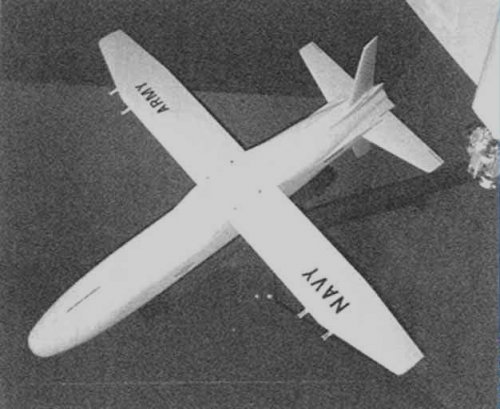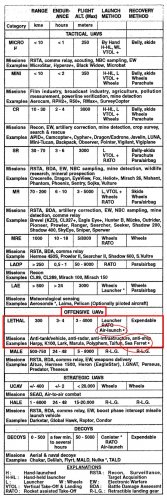- Joined
- 25 June 2009
- Messages
- 14,759
- Reaction score
- 6,165
Type
RSTA, BDA and precision attack UAV/cruise missile.
Development
The original Ferret was designed for launch from US Army helicopters such as the RAH-66 Comanche as a long-range extension of observation capability and/or as a standoff weapon.The Advanced Technology and Development Center of Northrop Grumman's Military Aircraft Systems Division originated the Ferret concept in August 1991, initially to support deep attack by helicopters at ranges beyond 300 km. The company built four air vehicles. All trials were conducted with the unpowered version. A derivative powered by a Sundstrand TJ50 miniature turbojet would have a maximum speed of 310kt and a range of over 600 km. The US Army evaluated Ferret under two Advanced Concepts and Technology II contracts, which included trials of the vehicle carrying a classified sensor payload on the Naval Air Warfare Center's China Lake range in the second quarter of 1995.

Sea Ferret
The Sea Ferret was a submarine-launched aerial reconnaissance drone developed by the U.S. Navy, designed to be launched from within a Sub-Harpoon missile canister and controlled by a submerged submarine to provide covert surveillance, weapons targeting, choke point interdiction, and battle damage assessment. While its primary mission was reconnaissance, Sea Ferret was a weapon, carrying a nine-kilogram (20 lb) warhead, capable of destroying smaller targets like command centers and surface-to-air missile launchers.The air vehicle can carry sensors for reconnaissance, surveillance, and target-acquisition (RSTA) missions, and a warhead allowing it to attack targets that it finds.
In an effort to promote the Sea Ferret as the subject of an advanced concept technology demonstration, the company collaborated with the USN, US Marine Corps (USMC) and US Army aviation components in a successful joint operational demonstration of Sea Ferret, sponsored by Commander Submarine Forces Pacific, in December 1996 onboard the Los Angeles-class attack submarine USSAsheville (SSN-758), cruising off the coast of southern California and simulating launches of Sea Ferret in support of three exercises over a two-day period.
A smaller version has also been envisaged for USAF use, carried either externally or inside the weapons bays of such aircraft as the F-117, F-22, JSF and B-2.The army considered sponsoring further development under a rapid-prototyping effort in early 1996, but the money was diverted to pay for operations in Bosnia. A Cessna 206 carrying the air vehicle beneath its wing represented Sea Ferret in flight.
General characteristics
More information
RSTA, BDA and precision attack UAV/cruise missile.
Development
The original Ferret was designed for launch from US Army helicopters such as the RAH-66 Comanche as a long-range extension of observation capability and/or as a standoff weapon.The Advanced Technology and Development Center of Northrop Grumman's Military Aircraft Systems Division originated the Ferret concept in August 1991, initially to support deep attack by helicopters at ranges beyond 300 km. The company built four air vehicles. All trials were conducted with the unpowered version. A derivative powered by a Sundstrand TJ50 miniature turbojet would have a maximum speed of 310kt and a range of over 600 km. The US Army evaluated Ferret under two Advanced Concepts and Technology II contracts, which included trials of the vehicle carrying a classified sensor payload on the Naval Air Warfare Center's China Lake range in the second quarter of 1995.
Sea Ferret
The Sea Ferret was a submarine-launched aerial reconnaissance drone developed by the U.S. Navy, designed to be launched from within a Sub-Harpoon missile canister and controlled by a submerged submarine to provide covert surveillance, weapons targeting, choke point interdiction, and battle damage assessment. While its primary mission was reconnaissance, Sea Ferret was a weapon, carrying a nine-kilogram (20 lb) warhead, capable of destroying smaller targets like command centers and surface-to-air missile launchers.The air vehicle can carry sensors for reconnaissance, surveillance, and target-acquisition (RSTA) missions, and a warhead allowing it to attack targets that it finds.
In an effort to promote the Sea Ferret as the subject of an advanced concept technology demonstration, the company collaborated with the USN, US Marine Corps (USMC) and US Army aviation components in a successful joint operational demonstration of Sea Ferret, sponsored by Commander Submarine Forces Pacific, in December 1996 onboard the Los Angeles-class attack submarine USSAsheville (SSN-758), cruising off the coast of southern California and simulating launches of Sea Ferret in support of three exercises over a two-day period.
A smaller version has also been envisaged for USAF use, carried either externally or inside the weapons bays of such aircraft as the F-117, F-22, JSF and B-2.The army considered sponsoring further development under a rapid-prototyping effort in early 1996, but the money was diverted to pay for operations in Bosnia. A Cessna 206 carrying the air vehicle beneath its wing represented Sea Ferret in flight.
General characteristics
- Weight: 145 lb (66 kg)
- Length: 75 in (1.9 m) long
- Range: 370 nautical miles (685 km)
- Loiter: 2 hours
- Speed: 300 knots (550 km/h) maximum, 80 knots (148 km/h) minimum
- Warhead: 20 lb (9 kg)
More information


